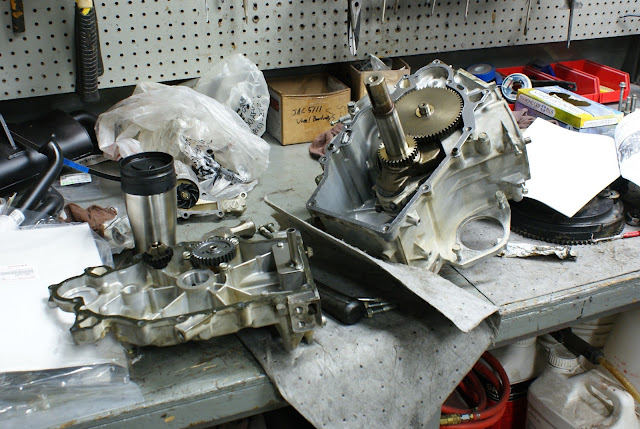One of the many things that golf course maintenance crews do over the winter is repair machinery. At Sugar Creek, we have a few machines to overhaul this winter including the greens mower. The greens mower is arguably the most important machine in the fleet. You certainly don't have a golf course without something to mow and groom greens.
Since 2008, we have mowed the greens with a John Deere 2500B with 11-blade reels and turf conditioners(or "groomers"). This unit has been used for 3650 hours so far and we are going to need it to continue to function for at least the next 2 seasons, maybe more. We rebuilt the reels two years ago, so they are in fine condition. The engine, however, was starting to show its age.
 |
| Gary on the greens mower |
This unit is powered by a liquid cooled, 2-cylinder, gasoline-powered Kawasaki FD620D. This engine has performed admirably for thousands of hours but, late last year, it began to leak oil from the crankshaft seals. A compression test revealed one cylinder had low compression and the other was marginal. I also discovered from other superintendents and message boards on the internet that this engine tends to lose oil pressure somewhere between 3500 and 4000 hours due to a worn out oil pump spur gear. This gear is plastic but is driven by the metal crankshaft. Eventually, the metal wins. See
this thread on My Tractor Forum for an example of what happens.
To avoid dripping oil on the green and a mid-season surprise, this engine either needed to be rebuilt or replaced. Replacing the engine and old exhaust was going to cost at least $3000. Since we have rebuilt a few v-twin engines recently, I was pretty confident we could rebuild for a lot less. A big thanks to Gary and Felix who did most of the work on this project.
Here is the greens mower after they pulled the engine:
 |
| John Deere 2500B |
Here is the engine partially disassembled. There was a lot of gunk behind the flywheel due to the leaking crankshaft seal:
 |
| Kawasaki FD620D |
Luckily, the major components of the engine were in good enough shape. We just needed a gasket set, new cylinder rings, and new valves. The cylinder walls just needed honing. Most of the important stuff -- cylinder size, crankshaft measurements, piston diameter, inside diameter of bearings, etc. -- were very close to factory specification and well within wear tolerances.
 |
| Cylinder and piston after the head was removed |
 |
| Piston after cleaning and ring removal |
 |
| Cylinder head with new seals and valves |
 |
| Inside of engine |
We decided to replace the valves instead of regrinding because the exhaust valves showed an uneven wear pattern indicating they were warped or the stem slightly bent. An engine shop with the right equipment could probably have saved them, but they are cheaper to replace at this point:
 |
| Engine valves |
The oil pump gear was indeed wearing out. If you look closely at the following pictures, you can see some teeth are smaller than others. The wear was all on one side of the teeth because that was the surface that provided resistance on the crankshaft gear. All it takes is one tooth to break or the gears to mesh wrong and the oil pump stops pumping. After that, it is not long before the engine seizes up. And believe me . . . you don't want to be stuck in the middle of the 4th green at 6 a.m. wondering how you are going to get a mower with a seized engine off a putting green before the golfers catch up to you. And without leaving ruts in the green 4 inches deep.
 |
| FD620D oil pump gear with worn teeth |
 |
| You can see the worn surfaces on the right side |
After everything was cleaned and inspected, reassembly was pretty easy.
 |
| Engine ready for reassembly |
 |
| Ready to close it up! |
The engine started up right away, after filling with oil and coolant of course. We tested the compression after running for an hour and got good results - about 190psi both sides. This engine should be good for many more hours now. We just have to cross our fingers that the electrical and hydraulic components hang in there.
 |
Back in action!
|



